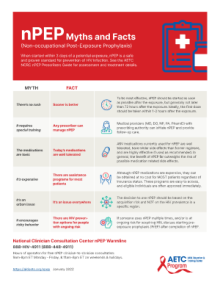
Non-occupational Post-Exposure Prophylaxis
When started within 3 days of a potential exposure, nPEP is a safe and proven standard for prevention of HIV infection. See the AETC NCRC nPEP Prescribers Guide for assessment and treatment details.
Myth: There’s no rush
Fact: Sooner is better
To be most effective, nPEP should be started as soon as possible after the exposure, but generally not later than 72 hours after the exposure. Ideally, the first dose should be taken within 1-2 hours after the exposure..
Myth: It requires special training
Fact: Any prescriber can manage nPEP
Medical providers (MD, DO, NP, PA, PharmD) with prescribing authority can initiate nPEP and provide follow-up care.
Myth: The medications are toxic
Fact: Today’s medications are well tolerated
ARV medications currently used for nPEP are well-tolerated, have milder side effects than former regimens, and are highly effective if used as recommended. In general, the benefit of nPEP as an HIV prevention method far outweighs the risk of possible medication related side effects.
Myth: It’s expensive
Fact: There are assistance programs for most patients
Although nPEP medications are expensive, they can be obtained at no cost for most patients regardless of insurance status. These programs are easy to access, and eligible individuals are often approved immediately.
Myth: It’s an urban issue
Fact: HIV is an issue everywhere
The decision to use nPEP should be based on the acquisition risk and not on the HIV prevalence in a specific region.
Myth: It encourages risky behavior
Fact: You can offer HIV prevention options for people with ongoing risk factors
If someone uses nPEP multiple times, and/or is at ongoing risk for acquiring HIV, discuss starting pre-exposure prophylaxis (PrEP) after completion of nPEP.
References and Resources
- CDC. Announcement: Updated Guidelines for Antiretroviral Postexposure Prophylaxis after Sexual, Injection-Drug Use, or Other Nonoccupational Exposure to HIV - United States, 2016. MMWR Morb Mortal Wkly Rep. 2016 May 6;65(17):458. doi: 10.15585/mmwr.mm6517a5. PMID: 27149423.
- AETC NCRC. Medication Assistance Programs for HIV prevention and treatment.
- HIV Care Tools: The AETC Program App with nPEP Quick Guide, and nPEP medication assistance program information.
